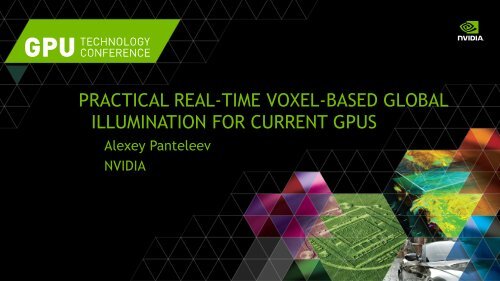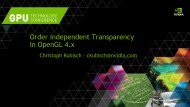S4552-rt-voxel-based-global-illumination-gpus
S4552-rt-voxel-based-global-illumination-gpus
S4552-rt-voxel-based-global-illumination-gpus
- No tags were found...
You also want an ePaper? Increase the reach of your titles
YUMPU automatically turns print PDFs into web optimized ePapers that Google loves.
WHAT IS GLOBAL ILLUMINATION?Here is a flashlight that lights the floor.3
WHAT IS GLOBAL ILLUMINATION?Here is a flashlight that lights the floor.Light bounces off the floorand hits the surrounding objects.4
WHAT IS GLOBAL ILLUMINATION?Here is a flashlight that lights the floor.Light bounces off the floorand hits the surrounding objects.And then it bounces off those objectsback to the floor.The process of computing these bouncesis called <strong>global</strong> <strong>illumination</strong>.5
HOW IT IS USUALLY SOLVED• Accurate physics-<strong>based</strong> GI computation is extremelyexpensive• Static approximations— Flat ambient— Light maps• Dynamic approximations— Manually placed lights simulating indirect <strong>illumination</strong>— Vi<strong>rt</strong>ual Point Lights – expensive, no occlusion— SH irradiance volumes, Light propagation volumes – no specular— Image-space approaches – incomplete scene information— Sparse Voxel Octree Global Illumination (SVOGI) – doesn’t handledynamic or large scenes well6
OUR SOLUTION• Dynamic approximation— No offline pre-computations— Handles dynamic scenes easily• Voxel Cone Tracing— “Interactive Indirect Illumination Using Voxel Cone Tracing” by CyrilCrassin, Fabrice Neyret, Miguel Sainz, Simon Green, Elmar Eisemann• Gathering information from a multi-resolution <strong>voxel</strong>representation of the scene7
SCREENSHOTS: DIRECT LIGHTING8
SCREENSHOTS: GI9
SCREENSHOTS: DIRECT LIGHTING10
SCREENSHOTS: GI11
SCREENSHOTS: AREA LIGHTS12
SCREENSHOTS: FLAT AMBIENT13
SCREENSHOTS: SSAO (HBAO+)14
SCREENSHOTS: VOXEL-BASED AMBIENTThe volumetric structure of the scene becomes obvious.15
OVERVIEW OF VOXEL CONE TRACING• Transform the scene into <strong>voxel</strong>s that encode opacity— Then downsample the opacity map• Render reflective shadow maps (RSMs)• Translate RSMs into another <strong>voxel</strong> map encoding emittance— Then downsample the emittance map• Gather light by tracing cones through the opacity andemittance maps16
OUR INNOVATION: 3D CLIPMAP• We store the <strong>voxel</strong> data in clipmaps— Multi-resolution texture— Regions near the center have higher spatial resolution— Seems to map naturally to cone tracing needs• A clipmap is easier to build than SVO— No nodes, pointers etc., handled by hardware• A clipmap is easier to read from— Same reasons• Clipmap size is (64…256)^3 with 3…5 levels of detail— 16…32 bytes per <strong>voxel</strong> => 12 MB … 2.5 GB of video memory required17
CLIPMAP VS. MIPMAPMIP-mapLOD 04096 elementsLOD 1512 elementsLOD 264 elementsLOD 38 elementsLOD 41 elementClipmapLOD 064 elementsLOD 164 elementsLOD 264 elementsLOD 38 elementsLOD 41 element18
UPDATING THE CLIPMAP DATAYYNew extentTexture extentObjects don’t moveworld-space Xworld-space X19
TOROIDAL ADDRESSINGA fixed point in space always maps to the same address in the clipmap.YY0, 1 1, 1 0, 11, 1 0, 1 1, 1 0, 11, 10, 0 1, 0 0, 0 1, 00, 1 1, 1 0, 11, 10, 0 1, 0 0, 0 1, 00, 1 1, 1 0, 11, 10, 0 1, 0 0, 0 1, 0 0, 0 1, 0 0, 0 1, 0world-space Xworld-space XThe background shows texture addresses: frac(worldPos.xy / levelSize.xy)20
INCREMENTAL UPDATES: CLIPMAP MOVESWhen the camera moves, most of the clipmap data remains valid.YY0, 1 1, 1 0, 11, 10, 1 1, 1 0, 11, 1Re<strong>voxel</strong>ized0, 0 1, 00, 0 1, 00, 0 1, 00, 0 1, 00, 1 1, 1 0, 11, 10, 1 1, 1 0, 11, 1Kept0, 0 1, 00, 0 1, 00, 0 1, 00, 0 1, 0world-space Xworld-space X21
VOXEL TEXTURE CONTENTS• Opacity textures— 3 or 6 opacity directions for each <strong>voxel</strong>— “How opaque is the <strong>voxel</strong> when viewed from a ce<strong>rt</strong>ain direction”— 3 for HQ tracing, 6 for LQ tracing: less self-shadowing— Stored as 1 or 2 RGB10A2 textures• Emittance textures— 3 or 6 emittance directions for each <strong>voxel</strong>— “How much light does the <strong>voxel</strong> emit to a ce<strong>rt</strong>ain direction”— 6 for HQ and second-bounce tracing, 3 for LQ tracing— Stored as 3 or 6 RGB10A2 sRGB textures (non atomically updatable)23
VOXELIZATION FOR OPACITY1. We have a triangle and a <strong>voxel</strong>.???This is one <strong>voxel</strong>.24
VOXELIZATION FOR OPACITY??2. Select the projection plane thatyields the biggest projection area(the back face in this case).?25
VOXELIZATION FOR OPACITY3. Rasterize the triangle usingMSAA to compute one coveragemask per pixel.?Actual MSAA pattern is different,but we translate those samplesonto a regular grid.?26
VOXELIZATION FOR OPACITY4. Now take the MSAA samples andreproject them onto other planesusing the triangle plane equation.27
VOXELIZATION FOR OPACITY5. Repeat that process for allcovered samples.28
VOXELIZATION FOR OPACITY6. Thicken the result by blurringall the reprojected samples.Some samples may go into thecloser or fu<strong>rt</strong>her <strong>voxel</strong>sdepending on the Z-slope of thetriangle.29
VOXELIZATION: SCENE GEOMETRY30
VOXELIZATION: DIRECTIONAL COVERAGE31
VOXELIZATION: OPACITY32
VOXELIZATION: DOWNSAMPLING 133
VOXELIZATION: DOWNSAMPLING 234
VOXELIZATION FOR EMITTANCE• Step 1: compute approximate brightness for each <strong>voxel</strong>— Use the coverage mask to weigh the emittance texture/color• Step 2: accumulate the brightness and normal in emittancetextures— There are 6 textures, one per direction, storing RGB10 sRGB data— Need R32U to perform atomics => 3 textures for emittance, 3 fornormal• Step 3: Conve<strong>rt</strong> the brightness data to directional emittance35
VOXELIZATION FOR EMITTANCE• Aliasing: small objects change apparent brightness abruptly• Appears on remote regions of the clipmap• Possible solutions are extreme (adaptive) supersampling andanalytical coverage computation• 8x MSAA pattern• Object covers:— Left: 4 samples— Right: 1 sample36
MULTI-RESOLUTION VOXELIZATION• MIP-map: downsample finer levels to get coarser levels• Clipmap: there are no finer levels for most of coarser levels• Rasterize every triangle at several resolutions— Obtain center regions of coarser levels by downsampling finer levels— Use GS instancing to rasterize one triangle several times37
MULTI-RESOLUTION VOXELIZATIONVoxelization with downsampling yields higher quality results than multi-res <strong>voxel</strong>ization.Rasterize… Downsample once Downsample twice38
LIGHT INJECTION• A process of calculating emittance of <strong>voxel</strong>s that containsurfaces lit by direct lights• We take information from reflective shadow maps (RSMs)RSM texelsShadow map raysAffected <strong>voxel</strong>s39
LIGHT INJECTION ALGORITHMS• Simplest option: test every <strong>voxel</strong> center against the RSM— Consider only <strong>voxel</strong>s with nonzero opacity— If a <strong>voxel</strong> is lit, take the color and normal from the RSM— Problems: aliasing, false lighting on object boundaries• Better option: gather all RSM texels that belong to the <strong>voxel</strong>— Many texture fetches per <strong>voxel</strong>, most of them are useless• Even better option: scatter RSM texels into <strong>voxel</strong>s usingatomic operations— Requires more memory, which we allocate sparsely in a separatetexture40
LIGHT INJECTION ALIASINGSlight changes in object or light positions sometimes change the lighting significantly.41
LIGHT INJECTION ALIASINGSlight changes in object or light positions sometimes change the lighting significantly.42
LIGHT INJECTION PRE-FILTERING• Need to pre-filter the RSM point cloud before injecting— Every texel will affect more than 1 <strong>voxel</strong> (3^3 or even 5^3)— Expensive to inject with scattering: atomics will be a bottleneck• Impractical to use the same filter kernel for all clip levels— A kernel that removes aliasing on all levels is very large• Different filter kernel sizes may result ininjected/downsampled mismatch43
CONE TRACING BASICS• Several cones are traced from every visible surface• A cone marches through the clipmap accumulating:— transparency (1-opacity)— <strong>illumination</strong> (emittance * transparency)Each sample is takenfrom a coarser LODthan the previous one. 10transparency<strong>illumination</strong>44
DIFFUSE AND SPECULAR CONE TRACINGDiffuseRough SpecularnFine Specularn45
SPARSE DIFFUSE CONE TRACING• Diffuse lighting is usually low-frequency— HQ cone tracing for every pixel is redundant• We trace every Nth pixel on the screen— N = 4…16— Rotated grid pattern to reduce aliasing• Interpolate using a bilateral filter— MSAA resolve fits naturally into the interpolation pass46
LIGHT LEAKINGIndirect lighting receiverUnilt samplesLit sampleLit surfacesA coarse <strong>voxel</strong>47
PERFORMANCE• Full GI is practical on current mainstream GPUs— e.g. GeForce GTX 770• Voxel-<strong>based</strong> AO works well on low-end GPUs, too— Looks much better than SSAO• GI processing time per frame, in ms:AO only Med High UltraGTX 650 (GK107) 14.3 28.1GTX 770 (GK104) 3.8 7.4 12.9GTX TITAN (GK110) 3.1 6.6 9.6 25.4@ 1920x108048
RENDERING TIME BREAKDOWNAllocation map updateOpacity representation update4%3%Emittance representation update17%Diffuse tracing and interpolation59%Specular tracing and filtering18%0% 10% 20% 30% 40% 50% 60% 70%Fraction of total GI processing timeHigh quality settings: 1920x1080, 17 cones, trace every 9 th pixel. GTX TITAN.49
CONCLUSION• Fully dynamic GI becomes practical on mainstream GPUs— Low end GPUs can benefit from much higher-quality AO• Future work— Fu<strong>rt</strong>her reduction of aliasing issues— Reduce the amount of content changes necessary• Planned to be released as NVIDIA GI Works library50
QUESTIONS?• mailto: alpanteleev@nvidia.com• Thanks:— Cyril Crassin Yury Uralsky— Evgeny Makarov Sergey Bolotov— Khariton Kantiev Alexey Barkovoy— Monier Maher Miguel Sainz— Holger Gruen51
BACKUP52
SPARSE DIFFUSE CONE TRACINGEvery 4 th pixel Every 9 th pixel Every 16 th pixel8.0 ms tracing0.7 ms interpolation4.0 ms tracing0.75 ms interpolation3.0 ms tracing0.8 ms interpolationMeasured on a GTX 680 at 1280x800, no AA, 17 diffuse cones.53
SPARSE DIFFUSE CONE TRACINGEvery 4 th pixel Every 9 th pixel Every 16 th pixelAnd now we slightly move the camera… See the difference.The left image is relatively stable, and the right image is more noisy.54
NOISY SPECULAR CONE TRACING• Tracing specular cones sparsely only works for flats— And a low tracing step is needed to avoid banding• Dense tracing is expensive due to small tracing step— Large step results in banding• We use noisy dense tracing:— Add a pseudo-random offset to every specular cone— Use a 4x4 blue noise matrix bound to screen pixels— Trace with step = 1.0 <strong>voxel</strong>s— Filter the results with a 4x4 kernel + bilateral55
SPECULAR BANDING REMOVALBanding in dense tracing Adding noise… And filtering that noise.The images are displayed with enhanced contrast.56



